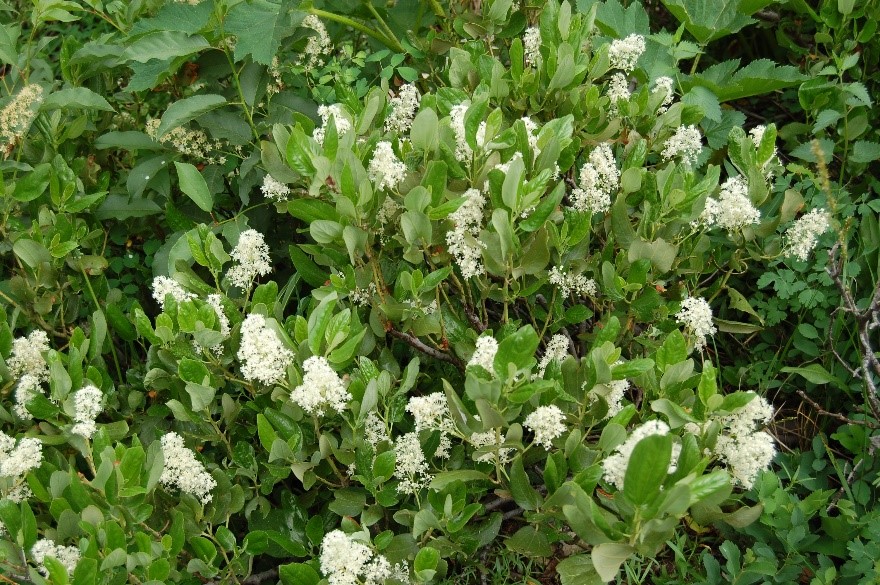Snowbrush Ceanothus in the Landscape

Larry A. Rupp, Utah State University
Scientfic Name: Ceanothus velutinusCommon Name: Snowbrush ceanothus, buckbrush, tobacco-brush, deerbrush
Description: Snowbrush ceanothus is a broadleaf evergreen shrub and a member of the Rhamnaceae or buckthorn family. Snowbrush plants vary from 2-9 feet in height and are found in a mounded form with spreading branches forming large thickets. It is easily identified by large evergreen leaves (up to 2-inches wide by 3-inches long). The leaves are alternate with a velvety underside and a sticky varnish-like coating on top that gives a very attractive shiny appearance to the leaves. The leaves have a distinctly pleasant odor resembling cinnamon or balsam that is especially noticeable in the autumn. The flowers occur from May to August and form white clusters. While snowbrush is cold hardy to high mountain elevations, that hardiness appears to be somewhat dependent on protection by snow cover with both frost patterns and the presence of winter snow cover evidently impacting distribution. It is also unique in that it forms a symbiotic relationship with the actinomycete Frankia resulting in root nodules that fix nitrogen. This plant has great potential for landscape use because it is moderately drought tolerant, nitrogen fixing, has beautiful white flowers, and is a broad-leaf evergreen. These characteristics make it a member of a limited and valuable group of plants.
Native Habitat: Snowbrush is native to western North America where it occurs at elevations of 6,000-11,000 feet. Typically, it is found on south facing slopes, though it can occur in all exposures. It is found in plant communities ranging from spruce-fir to aspen-conifer to mountain-brush or ponderosa pine. While snowbrush ceanothus grows in virtually all soils except heavy clays, it does best in well-drained, medium to coarse textured soils with a neutral to slightly acidic pH. It is a rapid colonizer following fire with plants developing from both seed and crown sprouting. The resulting thickets can be so dense as to inhibit the growth of other plants.
Cultural Requirement
Soil: Well drained, clay, sandy and full loams with a soil pH ranging from slightly acidic to moderately alkaline.
Moisture Tolerance: Moderately drought tolerant.
Sun/Shade/Preference: Full sun to partial shade, though in nature often covered by snow in the winter.
Transplanting: Unknown.
Propagation: In nature, propagation occurs by seed or by layering. Seeds can be difficult to collect because the seed pods burst on ripening and forcibly eject the seed. Harvested seed responds favorably to mild scarification or heat treatment followed by stratification. Cuttings can be propagated by treating with rooting hormone and placing under intermittent mist, thought they are difficult to propagate. Tip layering is also a means of propagation.
Maintenance (pruning, fertilization, deadheading, division, irrigation, etc): No information available.
Insect, disease, or other problems: In nature leaf galls are common. This species is susceptible to aphids and root rots during nursery propagation and production.
Landscape Value
Use in the Landscape: Useful as a specimen plant, understory with conifers, or as a foundation planting. It is not commonly available and when planted should be protected from winter sun and possible desiccation.
Weediness/Invasive Potential: Nonaggressive or invasive, but often treated as a weed in reclamation areas where attempts are being made to restore trees. Would not be considered to be weedy or aggressive in the landscape.
Foliage: Broadleaf, evergreen, alternate leaves, up to three inches long by two inches wide. Shiny upper surface with velvety under surface. Multiple shoots arise from a single crown with a strong taproot. Stems can be vertical or spreading with the overall shrub having a rounded top.
Flower: Flowers are white panicles less than 5-inches in length. They are born on the ends of shoots.
Timing: Bloom can be any time from May to August, depending on climatic conditions. Typically it occurs in late spring.
Fruit: Fruit is an inconspicuous 3-lobed capsule about ¼ inch in diameter. Each lobe contains one seed.
Form: Generally upright branches with a rounded head, some branches spreading.
Texture: Coarse texture, but with distinct shiny leaves.
Ultimate Size: Can grow from two to nine feet in height. Spreads by layering and can form dense thickets.
Rate of Growth: Slow growing. Flowers after 3-6 years of age.
Suggested Plant Partners: Fits well with most plants. Nice understory for conifers, maples, and scrub oak. Would make a nice evergreen backdrop for perennial flowers.
Availability: While common in nature it is not readily available in the trade.
Cultivars: None.
References:
Anonymous. Ceanothus velutinus. Fire Effects Information System. USDA Forest Service. https://www.fs.fed.us/database/feis/plants/shrub/ceavel/all.html
Shultz, Leila M.; Van Buren, Renee; Cooper, Janet G.; and Harper, Kimball T., "Woody Plants of Utah : A Field Guide with Identification Keys to Native and Naturalized Trees, Shrubs, Cacti, and Vines" (2011). Wildland Resources Faculty Publications. Paper 1645.
https://digitalcommons.usu.edu/wild_facpub/1645

